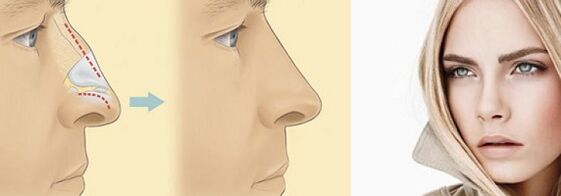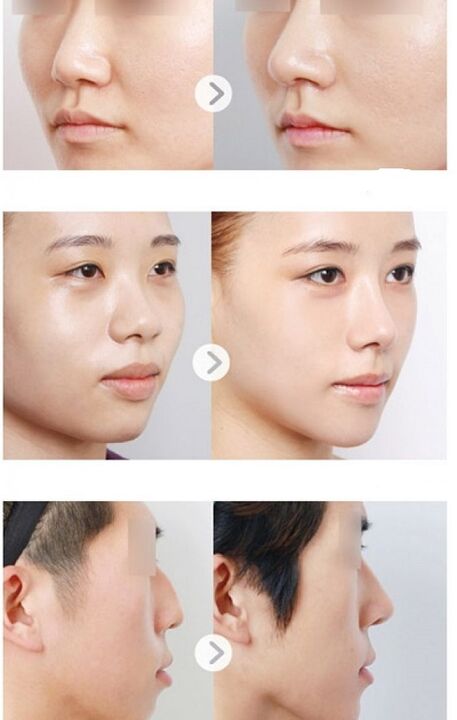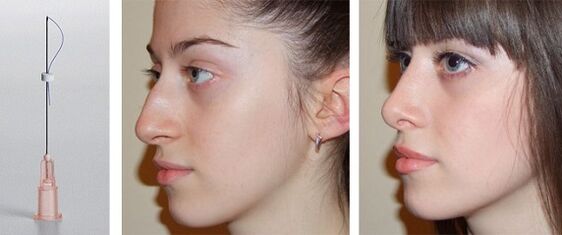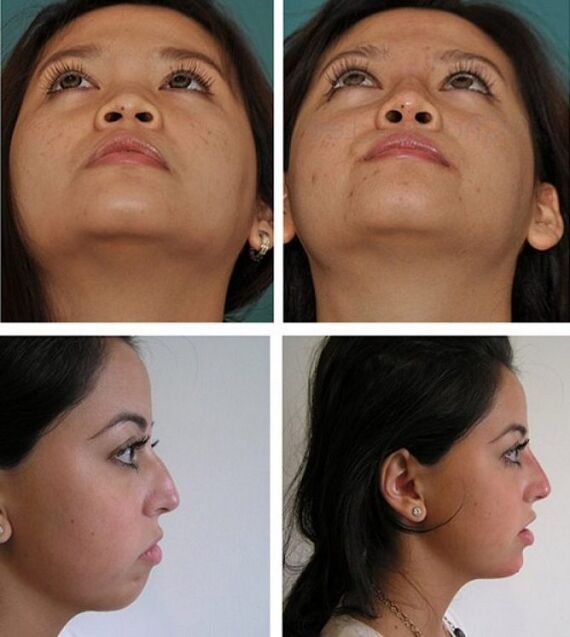One does not always like the shape of the nose, trying to find a solution to this problem. The choice lies ahead: they will have surgery or they will use a more gentle rhinoplasty method. Let us examine in more detail the characteristics of the non-surgical method of nasal correction, the indications and contraindications of the procedure, and the possible complications.

Peculiarities
Non-surgical plastic is a safe, simple method. It does not require significant time and material costs, the patient does not need anesthesia. It has recently become more and more popular due to its availability and efficiency. A special substance called a filler is injected into the correction zone. It acts as a kind of implant. With the help of such a rhinoplasty, you can remove the bump or bulge of the nose, making it even. But he won't squeeze his nose.
Before the procedure, you should consult a dermatologist who will help determine if you are allergic to the medicine you are using. Consultation with a therapist is also required. You must confirm that there are no contraindications. The surgeon performing the plastic surgery on the nose should first examine the patient and suggest the materials needed for correction. The doctor should be aware of the possible consequences and complications.
The procedure looks like this:
- the doctor determines the target areas;
- the patient lies down on the couch;
- a special anesthetic solution or cream is applied to the nose and face (you must wait 10 minutes for the medicine to take effect before proceeding with the correction);
- the doctor injects filler or inserts special fibers.
The procedure takes a maximum of half an hour. After that, the patient can safely go home.
Signs to change the shape of the nose
The shape of the nose is corrected with non-surgical fillers in the following cases:
- asymmetry;
- presence of irregularities, depression;
- peak error;
- flat back;
- the corners of the bridge of the nose are too sharp;
- restoration of shape after injury or unsuccessful surgical rhinoplasty;
- sagging skin;
- an Asian or African nose that the patient does not like;
- Contraindications to traditional rhinoplasty.
Drastic changes can only be achieved with the help of classical surgery. Sometimes non-surgical rhinoplasty is performed in order to see the possible outcome after classical surgery. The patient will be able to understand whether he likes the nose or not. But often this procedure is performed after surgical rhinoplasty, when minor irregularities remain. The correction is recommended for those who are afraid of classic rhinoplasty.

Contraindications
Although non-surgical nasal surgery is a simple procedure, it has several limitations. We talk about such pathologies:
- problems in the endocrine system;
- diabetes;
- oncology;
- allergy to the components of the medicine used for correction;
- immune system problems;
- bleeding.
In addition to the above factors in medicine, there are a number of contraindications that can be eliminated by changing the tip of the nose without surgery. These include:
- ARVI;
- pregnancy and lactation;
- cosmetic procedures (peeling and repainting) performed the day before;
- the period of exacerbation of chronic diseases;
- days of menstruation;
- inflammation of the skin of the nose.

Plastic methods
Non-surgical nasal surgery is performed using the following methods:
- gel fillers;
- hormonal drugs;
- mesothreads.
1. Gel filler
A special gel preparation is injected into the skin of the part of the nose that needs correction. Use the tools available. The procedure is inexpensive and there are no complications afterwards. But a significant disadvantage is the short-term effect (up to 6 months). The second can be done in six months.
Sometimes, instead of the filler, which has already dissolved, fibrous tissue is formed. The nose then takes an unchanged shape. In some cases, the injected drug overflows, leading to deformation. If this happens, the patient shows a second procedure.
2. Use of hormonal drugs
They help remove "extra" areas that degrade the look. If your doctor injects more than one medicine, it can lead to excessive dissolution of the tissues. Therefore, the physician requires increased care and accuracy. The change in the shape of the nose is caused by hormonal agents in several stages. Although the method gives good results, in some cases it leads to the development of atrophic processes.

3. Use of mesothreads
The tip and wings of the nose can be corrected with the help of special fibers. The doctor makes small punctures through which he inserts the thread and tightens the nose, giving it the required shape. After a few days, the ends of the remaining fibers are cut off. The main disadvantage is that scars may remain at the injection site, which worsens the appearance. Sometimes the inner thread breaks. But it all depends on the quality of the material and the professionalism of the doctor.
Advantages and disadvantages
Non-surgical rhinoplasty has advantages and disadvantages. The benefits include the following factors:
- speed of execution;
- lack of general anesthesia, which can negatively affect patient well-being;
- no surgery is required;
- the ability to observe the procedure by means of a mirror;
- the doctor may ask the patient if this nasal shape is right for him or if any area needs to be slightly corrected;
- lack of rehabilitation period;
- you can go home immediately after the procedure;
- lack of painful feelings;
- plastic is cheaper in this way.
Disadvantages include the following factors:
- the fragility of the result obtained (you must repeat the procedure to maintain the effect);
- once the gel is completely dissolved, the shape of the nose will be the same;
- if the plastic is done by an inexperienced professional who inserts the filler incorrectly, this can lead to displacement of the gel (the nose gets an ugly shape).

Rehabilitation period
After nasal surgery, doctors recommend minimizing contact with the corrected area. This threatens to displace the fillers, which can cause the shape to change.
After the procedure, it is recommended to leave for a while:
- alcoholic drinks;
- cigarette;
- prolonged solar radiation;
- saunas, swimming pools.
The final result will be noticeable 5-7 days after the procedure.
Side effects
Rhinoplasty without surgery does not cause serious complications. The patient may experience mild swelling, bruising, pain in the nose, which resolves very quickly without help.
In rare cases, the following side effects occur (both during and after the procedure):
- filler displacement;
- breaking of fibers;
- respiratory problems (this occurs especially in those who perform rhinoplasty very often);
- allergic reaction to the administered drug;
- herpes.
If a patient has been diagnosed with one of the side effects (except for an allergic reaction and herpes), they will be shown a second surgery.
Opinions and opinions
People try to find out as much as possible about the chosen procedure, look at the photos before and after the repair, read the reviews. Here is an example of several reviews:
- The first review: "Non-surgical plastic surgery was a salvation for my nose that looked" not very beautiful "before. I never thought it could change its appearance in 15 minutes. I hope the result lasts longer. When the drug is injecteddissolves, I am ready to repeat the procedure. "
- Second assessment: "I am 20 years old. I was persuaded to rhinoplasty by a non-surgical method by my mother, who had long been interested in her. Even at school, my nose was severely injured, which affected his appearance. He looked much better after the rhinoplasty. If finances allow, I’m ready to repeat it when the effect wears off. "
- Third Review: "I found reviews on the internet about a plastic surgery clinic. I was attracted by the availability of the services offered. But that was a mistake! The outcome of the procedure was disappointing. Don't be fooled by the prices! In my case, the saying worked: cheap cheese only in mousetraps. "
- The fourth tip: "After the nose correction, I started to feel a new way. I couldn’t stop looking at my reflection. Even my self-esteem has risen, which has been "lame" since I was 14, when everyone laughed at the tip of my nose. My opinion - I advise you to try and not be afraid. "
- Fifth Review: "I studied the opinions of those who had resorted to non-surgical rhinoplasty for a long time. In most cases, they were positive. Gathering my courage, I went to the clinic. My beloved nose was not a mistake, but a dignity. My husband really likes the result. "
Summary
Non-surgical plastics are the subject of debate among professionals. Some argue that this nasal correction method is ineffective and not worth wasting time on. In their opinion, the nose can be changed with the help of surgical rhinoplasty and nothing else. Others insist that the scalpel is "the last century. "But it all depends on the wishes of the patient, who must initially study the characteristics of each procedure, the results, and possible complications.
Comparing non-surgical and classical surgical rhinoplasty, we can only say that each has advantages and disadvantages. With the help of the operation, the shape of the nose changes forever and a significant amount is spent. It should not be forgotten that the rehabilitation period takes a lot of time. Non-surgical intervention is a simple and inexpensive procedure. But the main disadvantage is the fragility of the result obtained.
If the question is about changing the shape of your nose, it is important to consider the following factors:
- financial opportunity;
- presence of contraindications;
- readiness for long-term rehabilitation (if we are talking about classical surgery).
The cost of the procedure
The cost depends on the following factors:
- the professionalism of the doctor;
- the credibility of the clinic;
- the need to consult tight professionals;
- the price of materials;
- the complexity of a particular case.






















